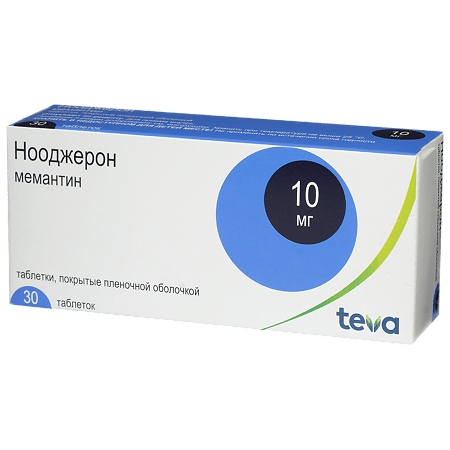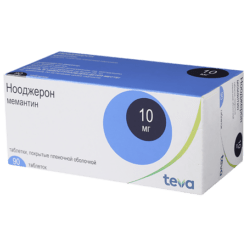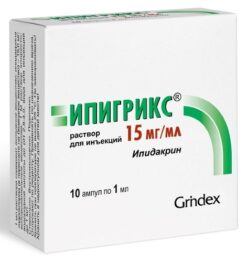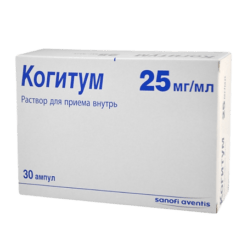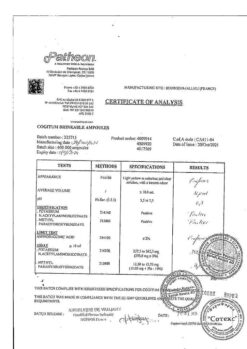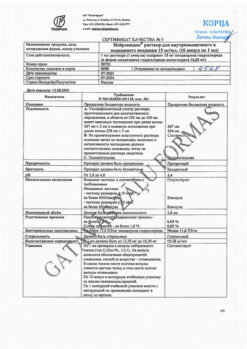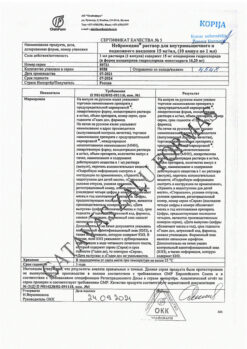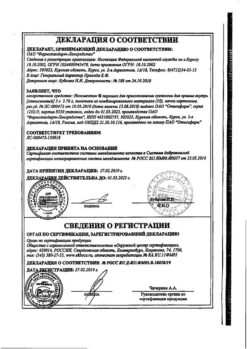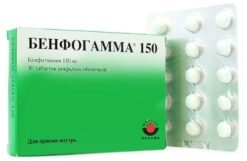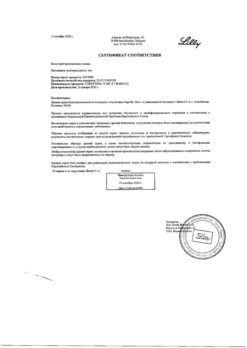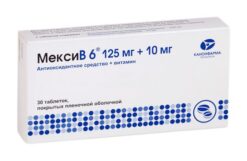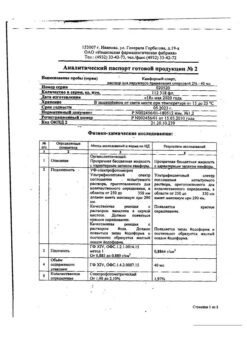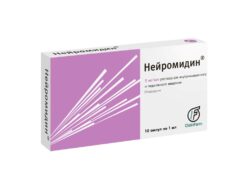Subtotal: €41.81
Noogeron, 10 mg 30 pcs.
€1.00
Out of stock
(E-mail when Stock is available)
Noogeron is a psychometabolic, nootropic.
Pharmacodynamics
A derivative of adamantane, similar to amantadine in chemical structure and pharmacological properties. It is a non-competitive antagonist of glutamate N-methyl-D-aspartate (NMDA)-receptors, (including in the substantia nigra), due to this it reduces excessive stimulating effect of cortical glutamate neurons on neostriatum, which develops against insufficient dopamine release. By reducing Ca2+ influx into neurons, it reduces the possibility of their destruction. It has nootropic, cerebrovasodilatory, antihypoxic and psychostimulatory effects. Has a greater effect on stiffness (rigidity and bradykinesia). It improves impaired memory and concentration, reduces fatigue and symptoms of depression.
Pharmacokinetics
It is rapidly and completely absorbed after oral administration. Cmax is reached 3-8 h after ingestion. Food has no effect on absorption. A daily dose of 20 mg results in a plasma Css of 70 to 150 ng/ml. Vd is 10 l/kg. Protein binding is 45%. 80% of circulating memantine in blood is represented by unchanged substance. Metabolism occurs without the participation of cytochrome P450. The main metabolites, N-3,5-dimethylgludantane (as 2 isomers) and 1-nitroso-3,5-dimethyl adamantane, have no pharmacological activity.
It is excreted by the kidneys. Elimination occurs monophasically, T1/2 is 60-100 h; clearance is 170 ml/min/1.73m2, the drug is partially secreted by the renal tubules. In alkaline urine excretion of the drug slows down.
Indications
Moderate to severe dementia in Alzheimer’s disease.
Pharmacological effect
Pharmacotherapeutic group: treatment for dementia.
ATX code: N06DX01.
Pharmacological properties
Pharmacodynamics
Adamantane derivative. It is a non-competitive antagonist of N-methyl-D-aspartate (NMDA) receptors and has a modulating effect on the glutamatergic system. Regulates ion transport, blocks calcium channels, normalizes membrane potential, improves the process of nerve impulse transmission. Improves cognitive processes, increases daily activity.
Pharmacokinetics
Suction
Eating does not affect the absorption of memantine. After oral administration, memantine is quickly and completely absorbed. Maximum concentration in blood plasma (Cmax) is from 3 to 8 hours after oral administration. In patients with normal renal function, no accumulation of memantine was observed.
Distribution
At a daily dose of 20 mg per day, equilibrium concentrations of memantine in blood plasma are 70-150 ng/ml. The ratio of the average concentration of memantine in the cerebrospinal fluid to the concentration in plasma when used in a daily dose of 5-30 mg is 0.52. The volume of distribution is approximately 10 l/kg. Approximately 45% of memantine is bound to plasma proteins.
Metabolism
About 80% of memantine taken orally is excreted unchanged. The main metabolites: N-3,5-dimethylgludantan, an isomeric mixture of 4- and 6-hydroxymemantine and 1-nitroso-3,5-dimethyladamantane do not have their own pharmacological activity. Under in vitro conditions, metabolism carried out by cytochrome P450 isoenzymes was not detected.
In a study of oral 14C-memantine, an average of 84% of the oral dose was excreted within 20 days, with more than 99% excreted by the kidneys.
Removal
Memantine is excreted monoexponentially with a terminal phase half-life (T1/2) of 60 to 100 hours. Excreted by the kidneys. In volunteers with normal renal function, the total clearance is 170 ml/min/1.73 m2, part of the total renal clearance is achieved through tubular secretion. Renal excretion also involves tubular reabsorption, possibly mediated by cationic transport proteins. The rate of renal elimination of memantine in conditions of alkaline urine reaction can be reduced by 7-9 times. Alkalinization of urine can be caused by a sudden change in diet, such as switching from animal products to a vegetarian diet or due to excessive use of alkaline gastric buffers.
Linearity
In the dose range of 10-40 mg in volunteers, linear pharmacokinetics were revealed.
Pharmacokinetic/pharmacodynamic relationship
When taking memantine at a dose of 20 mg/day, the concentration level in the cerebrospinal fluid is equal to the ki value (inhibition constant), which in the region of the frontal cortex is 0.5 µmol/l.
Special instructions
It is recommended to use with caution in patients with epilepsy, a history of seizures, or in patients with a predisposition to epilepsy.
Concomitant use of memantine and NMDA receptor antagonists such as amantadine, ketamine or dextromethorphan should be avoided. These compounds act on the same receptor system as memantine, therefore adverse reactions (mainly central nervous system related) may occur more frequently and be more severe.
The presence of factors in the patient that influence the increase in urine pH (abrupt dietary changes, for example, a transition from a diet that includes animal products to a vegetarian diet, or intensive consumption of alkaline gastric buffers), as well as renal tubular acidosis or severe urinary tract infections caused by Proteus spp., require careful monitoring of the patient’s condition.
From most clinical studies, patients with a history of myocardial infarction, decompensated chronic heart failure (NYHA functional class III-IV) or uncontrolled arterial hypertension were excluded. Therefore, data on the use of memantine in such patients is limited; the drug should be taken under close medical supervision.
Impact on the ability to drive vehicles and machinery
Patients with Alzheimer’s disease at the stage of moderate or severe dementia usually have impaired ability to drive vehicles and operate complex machines. In addition, memantine may cause changes in the reaction rate, so patients should refrain from driving vehicles or operating complex machinery.
Active ingredient
Memantine
Composition
1 tablet contains:
active ingredient: memantine hydrochloride 10.0 mg;
excipients: microcrystalline cellulose 102 136.8 mg, calcium hydrogen phosphate 84.5 mg, croscarmellose sodium 4.8 mg, colloidal silicon dioxide 1.5 mg, magnesium stearate 2.4 mg;
film shell: Opadry II gray 45F27505 8.0 mg (hypromellose-2910/15cP 2.5 mg, polydextrose 2.5 mg, titanium dioxide 2.48 mg, macrogol/macrogol-4000 0.5 mg, iron dye black oxide 0.02 mg).
Pregnancy
Due to possible intrauterine growth retardation, Noodzheron is not used during pregnancy. Animal studies indicate that the drug may cause intrauterine growth retardation when used in doses similar to therapeutic doses in humans.
There is no information on the excretion of memantine into breast milk. However, given the lipophilicity of memantine, isolation is possible. Therefore, during treatment with Noogeron, breastfeeding must be stopped.
Contraindications
Hypersensitivity to memantine and other components of the drug;
Severe liver failure (class C on the Child-Pugh scale);
Pregnancy and lactation;
Age up to 18 years (efficacy and safety have not been established).
With caution
Epilepsy, thyrotoxicosis, predisposition to the development of seizures, simultaneous use of NMDA receptor antagonists (amantadine, ketamine, dextromethorphan), factors that increase urine pH (sudden change of diet, for example, switching to vegetarianism, heavy intake of alkaline gastric buffers), renal tubular acidosis, severe urinary tract infections caused by Proteus spp., myocardial infarction (history), heart failure of III-IV functional class according to the NYHA classification, uncontrolled arterial hypertension, renal failure, liver failure.
Side Effects
Adverse effects are classified according to the frequency of their development: very common (≥ 1/10), common (≥ 1/100, < 1/10), uncommon (≥ 1/1000, < 1/100), rare (≥ 1/10000, < 1/1000), very rare (< 1/10000), unknown frequency - the available data are insufficient to estimate the frequency side effect.
Infectious and parasitic diseases: infrequently – fungal infections.
Immune system disorders: often – hypersensitivity to the components of the drug.
Mental disorders: often – drowsiness; infrequently – confusion, hallucinations*; unknown frequency: psychotic reactions.
Nervous system disorders: often – dizziness, balance problems; infrequently – gait disturbance; very rarely – convulsions.
Cardiac disorders: uncommon – heart failure.
Vascular disorders: often – increased blood pressure; uncommon – venous thrombosis and/or thromboembolism.
Gastrointestinal disorders: often – constipation; infrequently – vomiting, nausea; unknown frequency – pancreatitis.
Disorders of the liver and biliary tract: often – increased levels of “liver” enzymes; unknown frequency – hepatitis.
Disorders of the respiratory system, chest and mediastinal organs: often – shortness of breath.
General disorders and disorders at the injection site: often – headache; infrequently – fatigue.
* Hallucinations have mainly been observed in patients with Alzheimer’s disease in the advanced stages of dementia.
The following adverse reactions have been reported post-marketing: agranulocytosis, leukopenia (including neutropenia), pancytopenia, thrombocytopenia, thrombocytopenic purpura, hepatitis, acute renal failure, Stevens-Johnson syndrome.
Interaction
When used simultaneously with levodopa drugs, dopamine receptor antagonists, and m-anticholinergic blockers, the effect of the latter may be enhanced.
When used simultaneously with barbiturates and neuroleptics, the effect of the latter may decrease.
When used simultaneously, it may change (increase or decrease) the effect of dantrolene or baclofen, so the doses of the drugs should be selected individually.
Concomitant use with amantadine, ketamine, phenytoin and dextromethorphan should be avoided due to an increased risk of psychosis.
Plasma concentrations of cimetidine, ranitidine, procainamide, quinidine, quinine and nicotine may increase when taken simultaneously with memantine.
It is possible to reduce the level of hydrochlorothiazide when taken simultaneously with memantine.
There may be an increase in INR (international normalized ratio) in patients taking oral anticoagulants (warfarin).
Memantine may increase the excretion rate of hydrochlorothiazide.
Concomitant use with antidepressants, selective serotonin reuptake inhibitors and monoamine oxidase inhibitors requires careful monitoring of patients.
There is no pharmacokinetic interaction of memantine with glibenclamide, metformin, donepezil, or galantamine.
In vitro, memantine does not inhibit CYP1A2, 2A6, 2C9, 2D6, 2E1, 3A, flavin monooxidase, epoxide hydrolase, or sulfation.
Overdose
Symptoms
With relatively large overdoses (200 mg once and 105 mg/day for 3 days), the following symptoms were noted: fatigue, weakness and/or diarrhea or no symptoms.
In cases of overdose at a dose of 140 mg once or in case of taking an unknown dose, patients experienced adverse reactions from the central nervous system: confusion, hypersomnia, drowsiness, dizziness, agitation, aggression, hallucinations, gait disturbance and/or from the digestive system: vomiting, diarrhea.
In the most severe case of overdose (2000 mg of memantine), the patient survived, but adverse reactions from the nervous system were observed (coma for 10 days, then diplopia and agitation). The patient received symptomatic treatment and plasmapheresis.
The patient recovered without further complications. In another case of severe overdose (400 mg), the patient also survived and recovered. Adverse reactions from the central nervous system have been described: anxiety, psychosis, visual hallucinations, convulsive readiness, drowsiness, stupor and loss of consciousness.
Treatment
In case of overdose, symptomatic treatment is carried out. There is no specific antidote. You should use standard therapeutic measures to remove the active substance from the stomach, for example, gastric lavage, taking activated charcoal, acidifying urine, and possibly forced diuresis.
Storage conditions
Store at a temperature not exceeding 25ºС.
Keep out of the reach of children.
Shelf life
3 years.
Do not use after expiration date.
Manufacturer
Teva Operations Poland Sp. z o.o., Poland
| Shelf life | 3 years |
|---|---|
| Conditions of storage | At a temperature not exceeding 25 °C. |
| Manufacturer | Teva Operations Poland Sp. z o.o., Poland |
| Medication form | pills |
| Brand | Teva Operations Poland Sp. z o.o. |
Other forms…
Related products
Buy Noogeron, 10 mg 30 pcs. with delivery to USA, UK, Europe and over 120 other countries.


